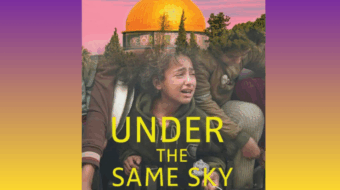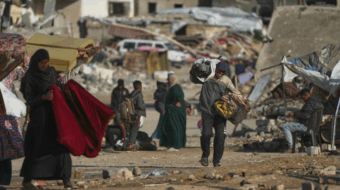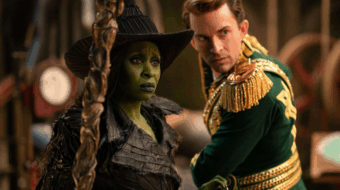
The title of Terri Ginsberg’s monograph Films of Arab Loutfi and Heiny Srour: Studies in Palestine Solidarity Cinema hardly hints at the theoretical breadth and depth of the work which is incredibly prescient in these perilous times as the world is once more on the brink of world war because of the unresolved issues in this area. This is also a densely layered essay that makes an important contribution not only to Arab film studies but, through its material and particular attention to Palestinian cinema, to film studies as a whole.
The monograph begins by asking the question of whether Palestine is still a critical issue. Ginsberg’s answer, anticipating the events of October 2023 and its aftermath, is a resounding “Yes.” It is her forthrightness and fidelity to the cause of Palestinian cinema that enables her to anticipate events, making this monograph so important as a primer for those who are frantically scrambling to catch up on the critical and theoretical issues behind Palestinian sovereignty and dispossession and Zionist incursions. These include, for example, contemporary work on a more expansive and transhistorical view of settler-colonialism that links Israeli invasions of Palestinian territory with U.S. “Manifest Destiny” and European subjugation of Asia and Africa. Important also are the ways the activism of the two filmmakers featured in the monograph highlights, through Ginsberg’s interpretation, longstanding issues in film and cultural studies around authorship, aura and memory, and trauma theory.
Ginsberg is an activist scholar and this work functions as a palimpsest, a layered and sedimented condensation of her work and concerns over the years in the following areas: materialist feminist theory; experimental cinema; the ideological uses of Holocaust studies; German philosophy and theory; a championing of genuine liberation and revolutionary cinema; a critique of an idealistic turn in cinema studies away from an original materialist basis; and an emphasis on the patriarchal aspects of Italian Neo-realism (on the efficacy of the last of which I disagree). The overlay of these elements results in a granular work that continually keeps its eye pointed in the direction of not only Palestinian but global liberation from the now stiflingly predatory menace of late-stage Western and particularly U.S. capitalism.
Walter Benjamin’s characterization of aura as 19th-century presence, widespread in 20th-century media, is here first critiqued as partially idealist and then turned on its head or re-envisioned in a détournement as “imminent practice grounded in a social ontos” (32). This redefinition features, as figured in Palestinian cinema, “a layering of disparate temporalities” that allows for, in this case, the simultaneous existence of not only pre- and post-Nakba sensibilities but also for comparisons, as Palestinians in the films recount, of the Nakba destruction of the Palestinian port of Tantura and European Judeocide under both the Nazis and Tsarist Russia. This layering also allows Ginsberg, through the work of the filmmakers, to question the delegitimization of Palestinian oral history as primitive, with that history of eyewitness accounts now supported by written accounts unearthed in the archives by Israeli scholars. This more materialist repositioning of aura then, in the Palestinian–Israeli context, is a counter to a nostalgic and fetishized past and the “value-free” positivist assessment of the colonial conquerors.

Ginsberg equally does a superb job of deconstructing “trauma studies” in the ever-expanding field of questions of memory as applied and corrected in the Palestinian instance. She notes the way some Israeli scholars have repositioned Palestinian reportage as re-narrations of the original trauma of the Nakba, the catastrophe. These memories are then mystified as psychological effects that can “neither be understood nor recreated” (54–55), the (Westernized) solution to which is not to change the situation but to therapize away the buried trauma of this “one-time event endlessly recalled.” In contrast, through the filmmakers’ examination of the materiality of these memories and the testimonies of continual colonial invasion and ethnic cleansing, the Nakba is represented not as a single instance but as an ongoing event and process that has been occurring persistently for over 75 years and one that necessitates a legitimate and legal resistance in the form of an anti-colonial struggle.
Finally, the concept of authorship, as highlighted in the Palestinian context, also comes in for revision. The monograph does indeed focus on the work of two female directors, not as abstracted “auteurs” but rather as part of “the social collective of political filmmakers” (14). Palestinian subjectivity itself, as defined in the films, is not so much individual but rather is social: The subjects of both these documentaries and fictions are portrayed as “complex embodiments of a history they have lived and are still helping to shape collectively.” Ginsberg’s reinterpretation of authorship utilizes Fredric Jameson’s figuration of “the author in discourse,” an extension of Marx’s men (and women) who make history but not of their own making. The addition here is that Ginsberg allows for the way the intervention of revolutionary fervor itself helps to fashion that discourse and the creative response to it.
This reinsertion of the timelessness of the Palestinian struggle could not arrive at a more perilous but also potentially progressive moment. Not only, per Francis Fukuyama, has history not ended with Western capitalism dominant and triumphant, but rather we are in a moment where for the majority of peoples in the world a new history—in the sense of their claims to an equal share of the world’s material abundance and the end of the long colonial nightmare—is just beginning. This monograph, in its recalling of a revolutionary past that is still present, is an extraordinary intervention in and furthering of that moment.
Terri Ginsberg
Films of Arad Loutfi and Heiny Srour: Studies in Palestine Solidarity Cinema
Hardcover: Palgrave Pivot, 2021
122 pp.
ISBN 10: 3030853535; ISBN 13: 9783030853532
We hope you appreciated this article. At People’s World, we believe news and information should be free and accessible to all, but we need your help. Our journalism is free of corporate influence and paywalls because we are totally reader-supported. Only you, our readers and supporters, make this possible. If you enjoy reading People’s World and the stories we bring you, please support our work by donating or becoming a monthly sustainer today. Thank you!










